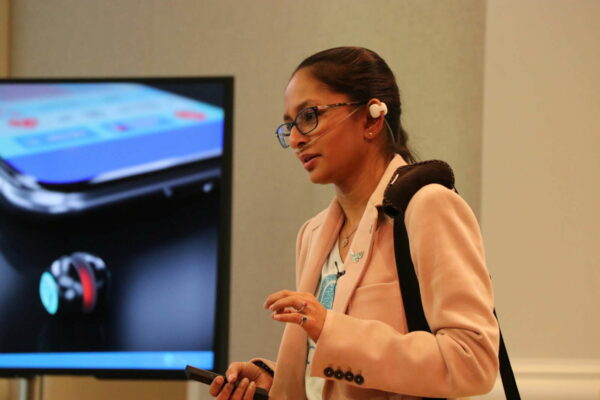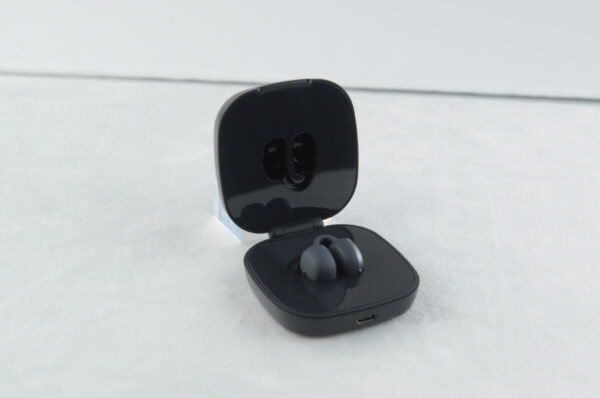
Sponsored by Monday Properties and written by ARLnow, Startup Monday is a weekly column that profiles Arlington-based startups, founders, and other local technology news. Monday Properties is proudly featuring 1515 Wilson Blvd in Rosslyn.
In 2017, while a graduate student at Georgetown University, Shavini Fernando’s heart suddenly stopped beating.
“I was working, and my friend started to scream that my entire face was blue,” said Fernando, who now lives in Arlington. “It didn’t even take one minute. I couldn’t breathe and my heart stopped.”
Fernando managed to revive herself by self-administering CPR before the oxygen supply to her brain cut out, but the incident frightened everyone around her. Fernando’s doctor at The Johns Hopkins Hospital suggested that it was no longer safe to live on her own.
But Fernando, who was unwilling to let the condition control her life, refused. Instead, she decided to develop a wearable device that continuously monitors her flow of oxygen with the help of her graduate school program director and fellow students. Whenever Fernando’s blood oxygen levels fell below a normal threshold, the ear-worn device sends an emergency alert to her doctor.
“I’m sort of a rebel. When people tell me ‘you can’t do this,’ I want to show them that I can,” Fernando said.

She channeled that fighting spirit two years prior, when a cardiologist told Fernando — who was 33 at the time — that she had just two years left to live. She flew from her home country of Sri Lanka to The Johns Hopkins Hospital in Baltimore for a second opinion and treatment. There, she received medicine and equipment to help manage severe pulmonary hypertension, a condition in which the heart has trouble pumping blood through the lungs. The condition leaves people vulnerable to sudden and undetected drops in oxygen, known as silent hypoxia.
This condition makes it dangerous to live in high altitudes, so rather than return home to Sri Lanka, she settled in the D.C. area to keep receiving medical treatment and start her master’s degree at Georgetown. That decision ultimately set her up to establish OxiWear so that she could share the product that she wears to survive with others.
“Most of the deaths happen in the pulmonary hypertension and cardiovascular patient community because they don’t get the help in time,” Fernando said. “If they have an alert and a way of calling for help, these deaths can be prevented.”
By the end of this year, Fernando and OxiWear plan to launch a product to be used by the public for fitness. A medical device for those with heart conditions will come later, once it gets approval from the Food and Drug Administration.
Both devices connect to a smartphone to show users their oxygen levels and enable them to contact emergency services during sudden drops.

OxiWear is now closing in on $1 million in funding since its launch in the spring of 2019. Most recently, after securing patents in the U.S, China and Japan, the company received investments from CIT Gap Funds and Tie DC. Before that, Fernando obtained funding through her connections at Georgetown and a crowdfunding campaign.
“Currently, there is no other device available to continuously monitor oxygen levels. OxiWear is a game changer for those affected by the complications of pulmonary hypertension, and could be the difference between safety and danger,” Tom Weithman, Managing Director of CIT GAP Funds, said in a press release.
Fernando says that investors and potential consumers initially expressed doubt about the importance of the product. As COVID-19 raised awareness of the dangers of silent hypoxia, however, OxiWear gained traction.
“Because of COVID-19, fundraising became really slow. At the same time, a lot of people started contacting us, asking, ‘Is there a way we can purchase this device?’ I’m like ‘I wish I could get it out fast, but we don’t have enough money,'” Fernando said.
In the early stages of the company, as funding dried up, Fernando and her employees went months without pay. Still, the OxiWear founder carried on.
“Even if it kills me, I will get this done. That’s why, even without funds, we’ve managed to get so far in such little time,” said Fernando. “For me, this is not about making money. It’s about helping those like me. Once you get silent hypoxia, even if you are recovered, you will end up with life-long after effects.”
Fernando and her OxiWear employees work remotely. The company’s address is publicly listed as a condo in Rosslyn.

